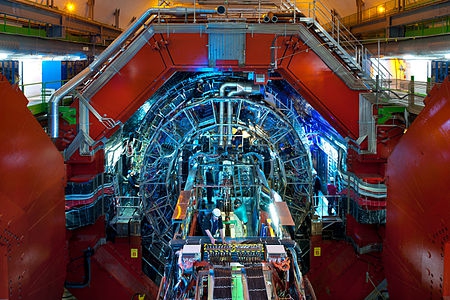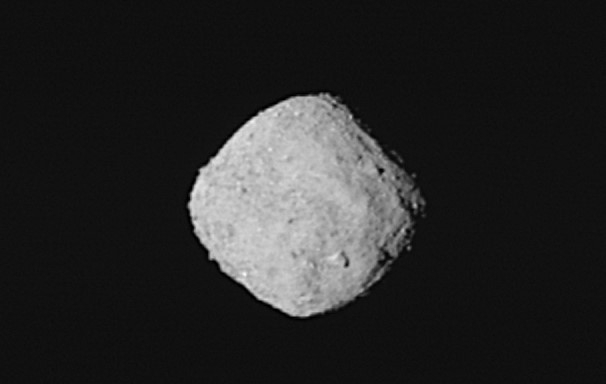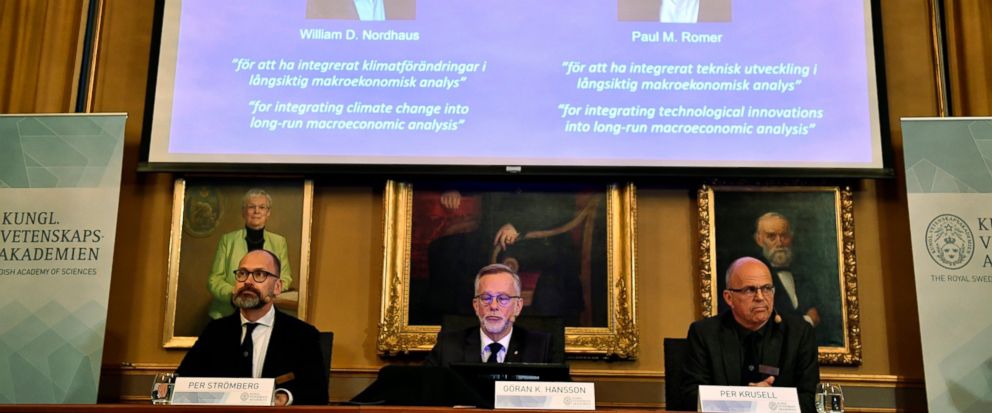As our nearest star, Sol, enters the quietest solar minimum in more than a century its time to take regular look at its activity, courtesy of USAF and NASA and otherwise as credited.

As our nearest star, Sol, enters the quietest solar minimum in more than a century its time to take regular look at its activity, courtesy of USAF and NASA and otherwise as credited.


The QGP, as the name suggests, is a special state consisting of the fundamental particles, the quarks, and the particles that bind the quarks together, the gluons. The result was obtained using the ALICE experiment at the 27 km long superconducting Large Hadron Collider (LHC) at CERN. The result is now published in Physics Letters
With collisions approaching the speed of light and enormous energy (5.44 TeV) a fireball lasting a mere 10-22 seconds was generated at temperatures of several thousand billion degrees.
Under these conditions a plasma of hadron components is created consisting of quarks and gluons. the density of the plasma is very high and forms a special state of matter known as the strongly interacting QGP.
The experiments suggest that the primordial matter, the instant before atoms formed, behaves like a liquid that can be described in terms of hydrodynamics.
The experiments involved studying the spatial distribution of the many thousands of particles that emerge from the collisions when the quarks and gluons have been trapped into the particles that the Universe consists of today. This reflects not only the initial geometry of the collision, but is sensitive to the properties of the QGP.

Source: Neils Bohr Institute
The first measurements of anisotropic flow coefficients vn for mid-rapidity charged particles in Xe–Xe collisions at sNN=5.44 TeV are presented. Comparing these measurements to those from Pb–Pb collisions at sNN=5.02 TeV, v2 is found to be suppressed for mid-central collisions at the same centrality, and enhanced for central collisions. The values of v3are generally larger in Xe–Xe than in Pb–Pb at a given centrality. These observations are consistent with expectations from hydrodynamic predictions. When both v2 and v3 are divided by their corresponding eccentricities for a variety of initial state models, they generally scale with transverse density when comparing Xe–Xe and Pb–Pb, with some deviations observed in central Xe–Xe and Pb–Pb collisions. These results assist in placing strong constraints on both the initial state geometry and medium response for relativistic heavy-ion collisions.

A riveting video from David Kipping at Astronomy Columbia. Is there life out there? We simply have no idea as it’s not possible to extrapolate from a single data point – Earth. It could well be that the creation of life is very difficult and we are the only example of life in our galaxy or indeed in the entire observable universe. We simply have no data to suggest otherwise. It would explain the absence of evidence of life in the radio spectrum and we have been looking for 50 years. The prospect that we are the only sentient beings within the observable universe (~30 billion light years across is both wonderful and rather terrifying.
That said it is interesting to contemplate that we and our animal relatives are likely the most complex entities on this planet and in this solar system. Given that we have seen no evidence of other sentient beings in the radio spectrum in the last 50 years or so it might also be reasonable to suggest that we are likely the most complex entities with hundreds of light years of Earth. It would however be nice if life were present in profusion elsewhere – but we simply do not know.
It might well be that it is us who are the “Aliens” and that over the next few hundred million years we will populate a vast region of this corner of our galaxy. I find this somehow very satisfying.
Steve Jobs was and remains a most enigmatic individual, driven by product excellence, focused to an obsessive degree but with little empathy for those around him. Below is a is an interesting paper on Jobs, by Bert McBrayer, within the framework of the Big 5 Personality traits. Bert concludes that history will likely paint Jobs as an innovator but likely not include him in the pantheon of leaders of people.
My take on Steve Jobs
Openness: Above average aspect Intellect but off the scale aspect Openness. Likely out of 100 people he would be more open to experience than the 99 other people in the room.
Conscientiousness: Off the scale aspect Industriousness but low in aspect Organization. What make Jobs unusual is the focus of his Industriousness.
Extraversion: Off the scale for both aspects Enthusiasm and Assertiveness
Agreeableness: Very low aspect Empathy and Politeness but could modify both if this furthered his product goals
Neuroticism: A reliable indicator of suitability for management is a low-level of Neuroticism or reaction and response to negative events. Jobs was legendary for his volatility but appears to have had low levels of withdrawal.
What appears to have made Jobs unique was his remarkable Industriousness and focus, combined with the creativity commensurate with above average intellect and exceedingly high openness. He used with pleasure his high Aspect Volatility in combination with his low Trait Agreeableness bound into a laser like product focus to stimulate his team. Steve was product and not people focused and may have retreated from the “scar tissue” of his rejection as an infant into the infinite detail of product design and artistic endeavour.
NASA’s OSIRIS-REx spacecraft after a 2 billion km journey, has reached and is now in orbit around asteroid Bennu. See previous post.
Below is a series of images taken by OSIRIS-REx at a distance of about 80 km (50 mi.) The images constitute one full revolution of the asteroid.
The spacecraft is now in the Preliminary Survey Phase which began on December 3, 2018, and marks the first time that the OSIRIS-REx spacecraft will operate around the asteroid. The spacecraft will make a total of five passes over the north pole, equator, and south pole at a range of 4.3 miles (7 km). The primary science goals of Preliminary Survey are to estimate Bennu’s mass, refine the asteroid’s spin state model, and generate a global shape model at a resolution of 75-cm. With this information orbital insertion can be planned and detailed (and close) survey of the asteroid can begin.
Its 4.5 billion years since our solar system formed in a gaseous nebula. These nebula formed from the explosive collapse of stars, larger than Sol, when they have exhausted much of their hydrogen. These Supernova cast much of their mass into space forming a gaseous nebula. These nebula are however large – much larger than our solar system and are incubators of star formation, sometimes hundreds of stars, much like the glowing nebula in the image below.

Composed of gas and dust, the pictured pillar resides in a tempestuous stellar nursery called the Carina Nebula, located 7500 light-years away in the southern constellation of Carina. Taken in visible light, the image shows the tip of the three-light-year-long pillar, bathed in the glow of light from hot, massive stars off the top of the image. Scorching radiation and fast winds (streams of charged particles) from these stars are sculpting the pillar and causing new stars to form within it. Streamers of gas and dust can be seen flowing off the top of the structure. Hubble’s Wide Field Camera 3 observed the Carina Nebula on 24-30 July 2009. The composite image was made from filters that isolate emission from iron, magnesium, oxygen, hydrogen and sulphur.
Overtime, the varied gravitational environment in the galaxy results in stars formed from the same nebula drifting apart, however they will retain the same composition and have similar spectral characteristics and maybe even be of comparable in size. Finding these siblings would require a massive star survey. We would have to know the distance from Earth, the relative speed and direction and the composition. Given that there are a vast number of stars in our immediate neighborhood – this is a daunting task.
The Gaia spacecraft is performing just such a survey of the Milky Way. Gaia is measuring the distance, velocity and spectral characteristics for a billion stars in our galaxy has now spotted what appears to be a twin (HD186302) of Sol and it has near identical spectral characteristics. Of the 200,000 stars in the spectral Gaia catalog only one star, HD186302, has near-identical chemistry to Sol.
HD186302 is a G3-Type main sequence star with about same surface temperature as Sol and is about the same age, 4.5 BY. HD186302 is located 184 light years from Earth, which sounds like it’s very distant. However, to achieve this separation if Sol and HB186302 were original 1-2 light-years apart within the nebula it would only require a relative velocity between Sol and HD186302 of 65,000 km/hr since formation to have achieved the current separation. In galactic terms this is a very realistic relative speed.
After the excitement of the Insight landing on Mars earlier in the week – there is more space adventure in store next week. OSIRIS-REx arrives at near-Earth asteroid 101955 Bennu, on Monday.
NASA’s Origins, Spectral Interpretation, Resource Identification, Security-Regolith Explorer (OSIRIS-REx) will make contact with Bennu at 1200 EST or 1700 Zulu.

There will be a live stream of the event at Nasa Live.
On Dec. 3, OSIRIS-REx will begin operations around the asteroid, passing over its north pole, south pole and equator at an altitude of only 6 km. This will allow the spacecraft to determine its mass, how fast it’s spinning and generate a model of the asteroid prior to retrieving a surface sample and returing it to planet Earth in 2023.
The journey for the asteroid-chasing OSIRIS-REx began back in September 2016 and three years later it’s finally close enough to tag the space rock. The spacecraft is equipped with five instruments and will survey the asteroid for a year, before selecting a site to retrieve a sample. OSIRIS-REx won’t touch down on the asteroid, like Japan’s Hayabusa 2 did earlier this year, instead opting to drop a lower pressure blower on an retractable arm (TAGSAM) onto the surface to suck up a sample for Earth return.
The OSIRIS-REx Laser Altimeter (OLA) will provide a 3-D map of asteroid Bennu’s shape, which will allow scientists to understand the context of the asteroid’s geography and the sample location. OLA is provided by the Canadian Space Agency in exchange for Canadian ownership of a portion of the returned asteroid sample. NASA’s OSIRIS-REx spacecraft will travel to the near-Earth asteroid Bennu and bring at least a 60-gram (2.1-ounce) sample back to Earth for study.
The OSIRIS-REx Thermal Emission Spectrometer (OTES) will conduct surveys to map mineral and chemical abundances and to take the asteroid Bennu’s temperature. OTES is the first such instrument built entirely on the Arizona State University (ASU), Tempe campus.
The OSIRIS-REx Visible and Infrared Spectrometer (OVIRS) will measure visible and near infrared light from the asteroid Bennu. The instrument’s observations could be used to identify water and organic materials.
The Regolith X-Ray Imaging Spectrometer (REXIS) instrument designed to image X-ray emission from Bennu in order to provide an elemental abundance map of the asteroid’s surface.
The TAGSAM arm will be responsible for collecting a sample from Bennu’s surface.
On December 1st, Spaceflight will launch its SSO-A satellite ride share on a Falcon 9 B1046 booster from Vandenberg on the west coast of the USA. SSO-A integrates 63 satellites into a single stack – in a single launch.
The ability to deploy this many satellites into low earth orbit makes launching small satellites increasing economic. With costs as low as $295,000 for a 5kg cube-sat – its simply changes the game. The pricing ranges from a high of $59k/kg for the smallest form-factor cube-sat of 34cm x 10cm x 10cm to $28k/kg for a 1000 kg 350cm x 200cm satellite.
The multi-satellite payload includes 49 CubeSats and 15 larger micro-satellites. They will be launched into sun-synchronous low-earth orbits.
The satellites belong to 34 government and commercial organizations from 17 countries — including the United States, Australia, India, Thailand, South Korea, Canada, Jordan, Kazakhstan, and nine European states (Italy, Netherlands, Finland, Spain, Switzerland, UK, Germany, Poland, and Brazil).
Headlines warned of economic doom after the U.S. government released its 4th National Climate Assessment (“NCA”). Steven Koonin takes a close look at the numbers and their impacts and concludes that the overall economic impact of human-caused climate change is anticipated to be very small indeed. We incorporate some of his comments in the commentary below. See end of this article for relevant NCA downloads.
Steven E. Koonin is a theoretical physicist and Director of the Center for Urban Science and Progress at New York University. He is also a professor in the Department of Civil and Urban Engineering at NYU’s Tandon School of Engineering. He was Under-Secretary of energy, during the Obama Administration.
As has been seen, particularly in the last 20 year, predicting the impact of human-caused carbon emissions on global climate has proved to be exceedingly challenging with estimates for surface temperature increases being uncertain by a factor of three. Further estimating the economic impacts of postulated temperature changes decades into the future, simply compounds the uncertainty and takes no account of our ingenuity in mitigating the impacts.
Koonin reports that on careful examination the report’s actual numbers as distinct from the hyperbole, turn out to be far less alarming. “The final figure of the final chapter shows that an increase in global temperatures of 9 F° (beyond the 1.4 F° rise recorded since 1880) would directly reduce the U.S. gross domestic product in 2090, by 4%, plus or minus 2% – that is the GDP would be 4% less than it would have been absent human influences on climate”.
This projection is a worst-case scenario assuming the largest plausible temperature increase. It takes no account of mitigation.
If we assume that the conclusion in the NCA report are correct, then it becomes obvious that the economic impact of any plausible temperature increase on the U.S or the global economy would be minimal. Indeed, any number of other impactors could have a far greater effect. For example, changes in regulations, trade, taxation, technology or external or internal conflicts could and have in the past had a far higher annual impact than the 0.05% reduction in GDP proposed by the NCA report. Further, a more likely scenario would be for a significantly lower temperature increase and the impact on GDP growth would be increasingly, un-measurable.
It is worth recalling the widely discredited claims made in 2006, by Nicholas Stern (the economic consultant for the British Prime Minister) when he published The Economics of Climate Change: The Stern Review, in which he wrote that if no timely actions were taken in the following decades, climate change would result in the loss of 5%–20% of global GDP. More than 10 years on and there is no evidence of his exaggerated GDP impacts. The IPCC 2014 report concluded that a 5 F° rise in temperature would have a 3% impact on global GDP by 2100 – which would diminish the growth in global GDP to 385% from 400%. Even the IPCC knows that the impact of any plausible global temperature increase is minimal at best.
The media and not surprisingly the political commentary on the NCA conclusions is little more than alarmist and even based upon the author’s own conclusions, the economic impact of postulated human-induced global temperature change is likely to be un-measurable over the short and probably the long term. The global economy has little to fear from human climate impacts.
Report in Brief
Chapter 28: Reducing Risks through Adaption Actions
Chapter 29: Reducing Risks through Mitigation
New Nobel laureate and Yale Professor, William Nordhaus says the costs of proposed CO2 cuts aren’t worth it.
Wall Street Journal, Bjorn Lomberg, 10th October 2018.
The global economy must be transformed immediately to avoid catastrophic climate damage, a new United Nations report declares. Climate economist William Nordhaus has been made a Nobel laureate. The events are being reported as two parts of the same story, but they reveal the contradictions inherent in climate policy—and why economics matters more than ever.

Limiting temperatures to 2.7 degrees Fahrenheit above pre-industrial levels, as the U.N.’s Intergovernmental Panel on Climate Change urges, is economically and practically impossible—as Mr. Nordhaus’s work shows.
The IPCC report significantly underestimates the costs of getting to zero emissions. Fossil fuels provide cheap, efficient power, whereas green energy remains mostly uncompetitive. Switching to more expensive, less efficient technology slows development. In poor nations that means fewer people lifted out of poverty. In rich ones it means the most vulnerable are hit by higher energy bills.
The IPCC says carbon emissions need to peak right now and fall rapidly to avert catastrophe. Models actually reveal that to achieve the 2.7-degree goal the world must stop all fossil fuel use in less than four years. Yet the International Energy Agency estimates that in 2040 fossil fuels will still meet three-quarters of world energy needs, even if the Paris agreement is fully implemented. The U.N. body responsible for the accord estimates that if every country fulfills every pledge by 2030, CO2 emissions will be cut by 60 billion tons by 2030. That’s less than 1% of what is needed to keep temperature rises below 2.7 degrees. And achieving even that fraction would be vastly expensive—reducing world-wide growth $1 trillion to $2 trillion each year by 2030.
The European Union promises to cut emissions 80% by 2050. With realistic assumptions about technology, and the optimistic assumption that the EU’s climate policy is very well designed and coordinated, the average of seven leading peer-reviewed models finds EU annual costs will reach €2.9 trillion ($3.3 trillion), more than twice what EU governments spend today on health, education, recreation, housing, environment, police and defense combined. In reality, it is likely to cost much more because EU climate legislation has been an inefficient patchwork. If that continues, the policy will make the EU 24% poorer in 2050.
Trying to do more, as the IPCC urges, would be phenomenally expensive. It is important to keep things in perspective, challenging as that is given the hysterical tone of the reaction to the panel’s latest offering. In its latest full report, the IPCC estimated that in 60 years unmitigated global warming would cost the planet between 0.2% and 2% of gross domestic product. That’s simply not the end of the world.
The new report has no comparison of the costs and benefits of climate targets. Mr. Nordhaus’s most recent estimate, published in August, is that the “optimal” outcome with a moderate carbon tax is a rise of about 6.3 degrees Fahrenheit by the end of the century. Reducing temperature rises by more would result in higher costs than benefits, potentially causing the world a $50 trillion loss.